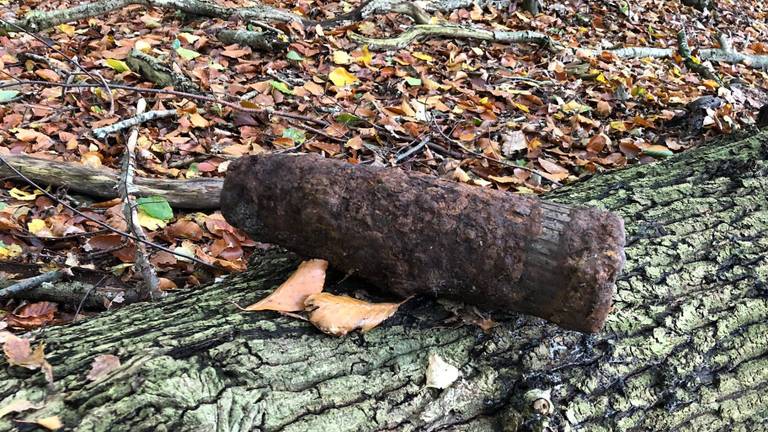12/11/2021 Olanda, Brabante Settentrionale, Bergen op Zoom
“If you ever come across anything suspicious like this item, please do not pick it up, contact your local law enforcement agency for assistance”
Op de Brabantse Wal is maandag een explosief uit de Tweede Wereldoorlog gevonden. Hij lag op een boomstam. Boswachter Erik de Jonge vermoedt dat iemand op zoek is geweest met een metaaldetector en het ding naast het pad heeft laten liggen. Een gevaarlijke actie. De Explosieve Opruimings Dienst (EOD) moet eraan te pas komen om de granaat weg te halen.
Foto-Bron: omroepbrabant.nl–Fieke Nobel
In the wooded area of Brabantse Wal, an artillery grenade dating back to the Second World War (and it’s not the first time) is placed on a tree trunk, The Forest Guard (photographer) Erik de Jonge assumes that an unconscious, reckless metal detectorist left the device. In fact, he too maintains that the area is always visited by capable hobbyists, but also by completely unprepared lone wolves who do not understand the danger of unexploded remnants of war.In fact, digging the residue (if you do not know the excavation techniques) is a dangerous action for oneself and for others in the that place at that moment.Lifting the grenade is a movement that could activate the functions of the fuze. Abandoning it on a tree trunk means endangering families and their children who frequent the area daily. What can I say, now? We hope to write nevermore stories like this one. And we hope these people can understand that any remnant of war (first and second world wars), if activated, is still able to complete its task. Tiziana Piscitelli
Nell’area boschiva del Brabantse Wal, è posato su un tronco d’albero una granata d’artiglieria risalente alla seconda guerra mondiale (non è la prima volta), La Guardia Forestale (fotografo) Erik de Jonge, suppone che ad abbandonare l’ordigno sia stato qualche incosciente, sconsiderato metaldetectorista. Infatti anche lui sostiene che la zona è sempre visitata da hobbisti capaci, ma anche lupi solitari del tutto impreparati che non comprendono il pericolo dei residuati bellici inesplosi. Difatti scavare il residuato (se non conosci le tecniche di scavo) è azione pericolosa per se e per chi in quel momento transita sul posto. Sollevare la granata è un movimento che potrebbe azionare le funzioni della spoletta. Abbandonarla su un tronco d’albero significa mettere in pericolo famiglie e rispettivi bambini che giornalmente frequentano la zona. Che dire? Speriamo di non scrivere più vicende come queste. E speriamo che queste persone possano capire che ogni residuato bellico (prima e seconda guerra mondiale) se sollecitato, ancora oggi è sempre in grado di portare di termine il compito per cui è stato costruito.
Foto: Hier werd de granaat achtergelaten (foto: Erik de Jonge)
In Nijmegen is het sowieso verboden om met een metaaldetector te zoeken.’Kom je zomaar onverwacht een vliegtuigbom of andere munitie tegen, bel dan de politie via 112, zo luidt het advies van de gemeente. Als het nodig is, schakelt de politie de EOD in. Die opruimingsdienst neemt dan verdere veiligheidsmaatregelen, bijvoorbeeld een ontruiming van het gebied.
Dear editors, Biography of a bomb is aimed at highlighting the danger caused by unexploded bombs. Moreover, the most important aspect is that we work completely non profit, raising awerness about this topic is what drives us. We apologize if we make use of pictures in yours articles, but we need them to put a context in how findings are done. We will (and we always do) cite source and author of the picture. We thank you for your comprehension





